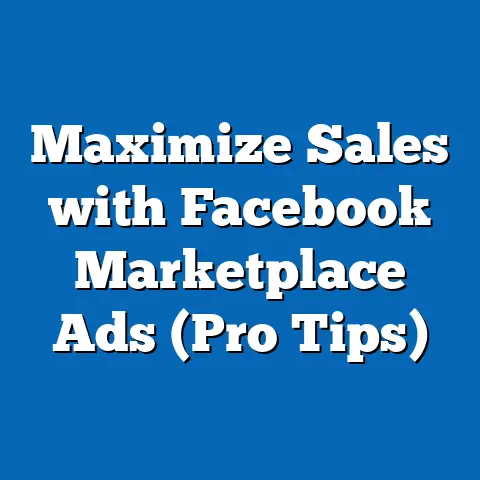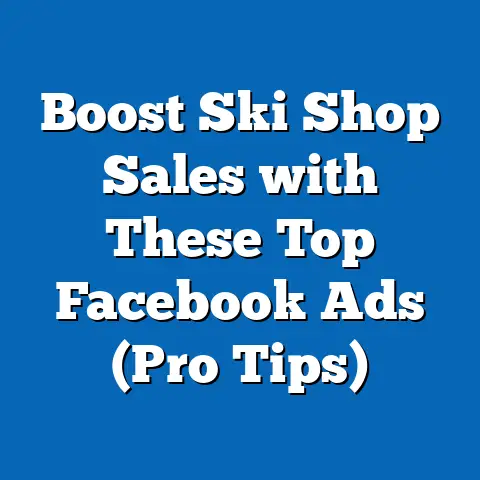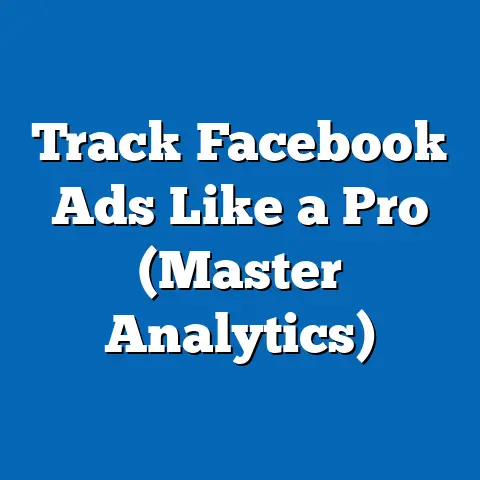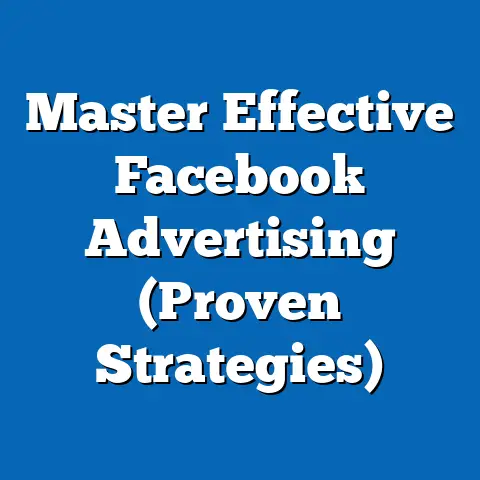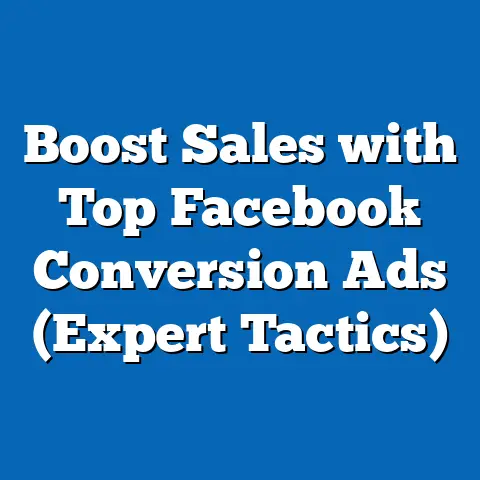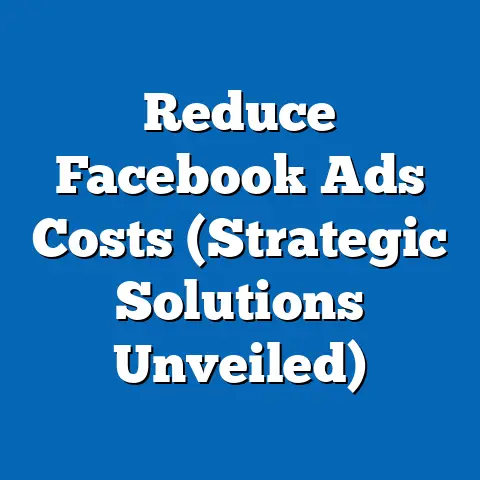Cut High CPM Facebook Ads Costs (Proven Strategies)
This guide is your comprehensive roadmap to achieving just that. I’m going to share proven strategies, backed by real-world examples and data, that will help you cut those high CPM Facebook Ads costs and boost your ROI.
Understanding CPM in Facebook Ads
CPM, as I mentioned, stands for Cost Per Mille, or Cost Per Thousand Impressions. It’s the amount you pay every time your ad is shown one thousand times. Think of it as the price of visibility. A high CPM means you’re paying more to reach the same number of people, which can quickly eat into your budget.
Why CPM Matters
CPM is more than just a number; it’s a key indicator of your ad’s efficiency and effectiveness. Here’s why it’s crucial to keep an eye on:
-
Budget Control: A lower CPM means you can reach more people with the same budget. It’s simple math.
-
ROI Improvement: By reducing your CPM, you increase the return on your investment (ROI). If you’re paying less for each impression, your overall cost per acquisition (CPA) should also decrease.
-
Competitive Advantage: In competitive industries, a lower CPM can be a game-changer. It allows you to outspend your competitors and capture more market share.
Budget Control: A lower CPM means you can reach more people with the same budget. It’s simple math.
ROI Improvement: By reducing your CPM, you increase the return on your investment (ROI). If you’re paying less for each impression, your overall cost per acquisition (CPA) should also decrease.
Competitive Advantage: In competitive industries, a lower CPM can be a game-changer. It allows you to outspend your competitors and capture more market share.
Factors Influencing CPM
Several factors influence your CPM rates on Facebook. Understanding these can help you pinpoint areas for improvement:
-
Audience Targeting: The more specific and niche your audience, the higher the CPM tends to be. Highly sought-after demographics and interests often come with a premium.
-
Ad Relevance: Facebook rewards ads that are relevant to the audience. Ads with high engagement (likes, shares, comments) typically have lower CPMs because Facebook sees them as providing value to users.
-
Competition: The more advertisers targeting the same audience, the higher the CPM. During peak seasons like holidays, competition increases, driving up costs.
-
Ad Placement: Different placements (e.g., Facebook News Feed, Instagram Stories, Audience Network) have different CPMs. Placements with higher visibility often cost more.
-
Ad Quality: The quality of your ad creative (images, videos, and copy) significantly impacts CPM. Low-quality or irrelevant ads will result in higher CPMs.
-
Bidding Strategy: The bidding strategy you choose (e.g., lowest cost, target cost, bid cap) affects your CPM. Some strategies are more aggressive and may lead to higher costs.
-
Seasonality: CPMs tend to fluctuate based on the time of year. As I mentioned before, holidays and major shopping events usually see a spike in CPM due to increased advertising activity.
Audience Targeting: The more specific and niche your audience, the higher the CPM tends to be. Highly sought-after demographics and interests often come with a premium.
Ad Relevance: Facebook rewards ads that are relevant to the audience. Ads with high engagement (likes, shares, comments) typically have lower CPMs because Facebook sees them as providing value to users.
Competition: The more advertisers targeting the same audience, the higher the CPM. During peak seasons like holidays, competition increases, driving up costs.
Ad Placement: Different placements (e.g., Facebook News Feed, Instagram Stories, Audience Network) have different CPMs. Placements with higher visibility often cost more.
Ad Quality: The quality of your ad creative (images, videos, and copy) significantly impacts CPM. Low-quality or irrelevant ads will result in higher CPMs.
Bidding Strategy: The bidding strategy you choose (e.g., lowest cost, target cost, bid cap) affects your CPM. Some strategies are more aggressive and may lead to higher costs.
Seasonality: CPMs tend to fluctuate based on the time of year. As I mentioned before, holidays and major shopping events usually see a spike in CPM due to increased advertising activity.
Takeaway: Understanding the factors that influence CPM is the first step to controlling it. By identifying which factors are driving up your costs, you can start implementing targeted strategies to lower them.
Analyze Your Audience Targeting
One of the most impactful ways to reduce your CPM is by refining your audience targeting. I’ve seen countless campaigns where simply tweaking the audience parameters resulted in significant cost savings.
The Power of Precise Targeting
Precise targeting means reaching the right people with the right message. When your ads resonate with the audience, they’re more likely to engage, which lowers your CPM. Facebook offers a wealth of targeting options, including demographics, interests, behaviors, and connections.
Using Facebook’s Audience Insights
Facebook’s Audience Insights tool is a goldmine for understanding your target audience. It provides detailed information about demographics, interests, page likes, location, and even purchase behavior. Here’s how to use it effectively:
-
Access Audience Insights: Go to Facebook Ads Manager and navigate to “Audience Insights.”
-
Define Your Audience: Start by selecting a broad audience (e.g., everyone on Facebook) or a specific audience (e.g., people who like your page).
-
Explore Demographics: Analyze the age, gender, education level, and relationship status of your audience.
-
Uncover Interests: Discover the top interests and page likes of your audience. This can reveal valuable insights into their preferences and behaviors.
-
Analyze Location: See where your audience is located and tailor your ads accordingly.
-
Review Purchase Behavior: Understand the purchasing habits of your audience, including their preferred payment methods and online spending habits.
Access Audience Insights: Go to Facebook Ads Manager and navigate to “Audience Insights.”
Define Your Audience: Start by selecting a broad audience (e.g., everyone on Facebook) or a specific audience (e.g., people who like your page).
Explore Demographics: Analyze the age, gender, education level, and relationship status of your audience.
Uncover Interests: Discover the top interests and page likes of your audience. This can reveal valuable insights into their preferences and behaviors.
Analyze Location: See where your audience is located and tailor your ads accordingly.
Review Purchase Behavior: Understand the purchasing habits of your audience, including their preferred payment methods and online spending habits.
Creating Custom Audiences
Custom Audiences allow you to target people who have already interacted with your business. This can include website visitors, email subscribers, or app users. Here’s how to create them:
-
Website Visitors: Install the Facebook Pixel on your website to track visitor behavior. Then, create a Custom Audience of people who have visited specific pages or taken certain actions (e.g., added items to their cart).
-
Email Subscribers: Upload your email list to Facebook to target your subscribers with relevant ads.
-
App Users: Target people who have downloaded and used your mobile app.
-
Engagement Audiences: Target people who have engaged with your Facebook or Instagram content (e.g., watched your videos, liked your posts).
Website Visitors: Install the Facebook Pixel on your website to track visitor behavior. Then, create a Custom Audience of people who have visited specific pages or taken certain actions (e.g., added items to their cart).
Email Subscribers: Upload your email list to Facebook to target your subscribers with relevant ads.
App Users: Target people who have downloaded and used your mobile app.
Engagement Audiences: Target people who have engaged with your Facebook or Instagram content (e.g., watched your videos, liked your posts).
Leveraging Lookalike Audiences
Lookalike Audiences are one of my favorite tools for expanding reach while maintaining relevance. They allow you to target people who are similar to your existing customers or website visitors. Here’s how to use them:
-
Choose a Source Audience: Select a Custom Audience (e.g., your email list or website visitors) as the source for your Lookalike Audience.
-
Select a Location: Choose the country or region you want to target.
-
Choose an Audience Size: Select the size of your Lookalike Audience (e.g., 1% to 10% of the population). A smaller percentage will be more similar to your source audience, while a larger percentage will have broader reach.
Choose a Source Audience: Select a Custom Audience (e.g., your email list or website visitors) as the source for your Lookalike Audience.
Select a Location: Choose the country or region you want to target.
Choose an Audience Size: Select the size of your Lookalike Audience (e.g., 1% to 10% of the population). A smaller percentage will be more similar to your source audience, while a larger percentage will have broader reach.
A/B Testing Audience Segments
A/B testing different audience segments is crucial for identifying which yields the lowest CPM. Here’s how to do it:
-
Create Multiple Ad Sets: Create multiple ad sets with different audience targeting options.
-
Run Identical Ads: Use the same ad creative and copy in each ad set to ensure a fair comparison.
-
Monitor Performance: Track the CPM, reach, and engagement of each ad set.
-
Optimize: Focus your budget on the ad sets with the lowest CPM and highest engagement.
Create Multiple Ad Sets: Create multiple ad sets with different audience targeting options.
Run Identical Ads: Use the same ad creative and copy in each ad set to ensure a fair comparison.
Monitor Performance: Track the CPM, reach, and engagement of each ad set.
Optimize: Focus your budget on the ad sets with the lowest CPM and highest engagement.
Personal Story: I once worked with an e-commerce client who was struggling with high CPMs. After analyzing their audience data, we discovered that their ads were being shown to a broad demographic with little interest in their products. By creating a Lookalike Audience based on their existing customers and refining their interest targeting, we were able to reduce their CPM by 40% and significantly increase their sales.
Takeaway: Precise audience targeting is essential for reducing CPM costs. Use Facebook’s Audience Insights, create Custom Audiences and Lookalike Audiences, and A/B test different audience segments to find the most cost-effective options.
Optimize Ad Creative and Copy
Your ad creative and copy play a massive role in determining your CPM. High-quality, engaging ads are rewarded by Facebook with lower costs, while irrelevant or poorly designed ads will cost you more.
The Impact of Ad Creative
Ad creative includes the visuals (images and videos) and the copy (text) used in your ads. It’s the first thing people see, and it determines whether they’ll stop scrolling and pay attention.
-
High-Quality Visuals: Use professional-quality images and videos that are visually appealing and relevant to your target audience.
-
Compelling Copy: Write clear, concise, and persuasive copy that highlights the benefits of your product or service.
-
Relevance: Ensure your ad creative is relevant to your audience’s interests and needs.
High-Quality Visuals: Use professional-quality images and videos that are visually appealing and relevant to your target audience.
Compelling Copy: Write clear, concise, and persuasive copy that highlights the benefits of your product or service.
Relevance: Ensure your ad creative is relevant to your audience’s interests and needs.
Proven Techniques for Engaging Ad Content
Here are some proven techniques for creating engaging ad content:
-
Tell a Story: Use storytelling to connect with your audience on an emotional level. Share customer testimonials or behind-the-scenes glimpses of your business.
-
Use Strong Visuals: Use eye-catching images and videos that grab attention. Consider using bright colors, bold graphics, and interesting compositions.
-
Highlight Benefits: Focus on the benefits of your product or service rather than just the features. Explain how it will solve a problem or improve your audience’s lives.
-
Create Urgency: Use language that creates a sense of urgency, such as “Limited Time Offer” or “Shop Now Before It’s Too Late.”
-
Ask Questions: Engage your audience by asking questions that prompt them to think about their needs and desires.
Tell a Story: Use storytelling to connect with your audience on an emotional level. Share customer testimonials or behind-the-scenes glimpses of your business.
Use Strong Visuals: Use eye-catching images and videos that grab attention. Consider using bright colors, bold graphics, and interesting compositions.
Highlight Benefits: Focus on the benefits of your product or service rather than just the features. Explain how it will solve a problem or improve your audience’s lives.
Create Urgency: Use language that creates a sense of urgency, such as “Limited Time Offer” or “Shop Now Before It’s Too Late.”
Ask Questions: Engage your audience by asking questions that prompt them to think about their needs and desires.
Testing Different Ad Formats
Facebook offers a variety of ad formats, including:
-
Single Image Ads: Simple and effective for showcasing a single product or message.
-
Single Video Ads: Great for capturing attention and telling a story.
-
Carousel Ads: Allow you to showcase multiple products or features in a single ad.
-
Collection Ads: Ideal for e-commerce businesses, allowing users to browse and purchase products directly from the ad.
-
Instant Experience Ads: Full-screen, mobile-optimized ads that provide an immersive experience.
Single Image Ads: Simple and effective for showcasing a single product or message.
Single Video Ads: Great for capturing attention and telling a story.
Carousel Ads: Allow you to showcase multiple products or features in a single ad.
Collection Ads: Ideal for e-commerce businesses, allowing users to browse and purchase products directly from the ad.
Instant Experience Ads: Full-screen, mobile-optimized ads that provide an immersive experience.
Testing different ad formats is crucial for identifying which performs best with your target audience. Pay attention to the following performance metrics:
-
Click-Through Rate (CTR): The percentage of people who click on your ad. A higher CTR indicates that your ad is relevant and engaging.
-
Conversion Rate: The percentage of people who take a desired action (e.g., make a purchase, fill out a form) after clicking on your ad.
-
Cost Per Click (CPC): The amount you pay for each click on your ad.
-
CPM: As we’ve discussed, CPM is the cost per thousand impressions.
Click-Through Rate (CTR): The percentage of people who click on your ad. A higher CTR indicates that your ad is relevant and engaging.
Conversion Rate: The percentage of people who take a desired action (e.g., make a purchase, fill out a form) after clicking on your ad.
Cost Per Click (CPC): The amount you pay for each click on your ad.
CPM: As we’ve discussed, CPM is the cost per thousand impressions.
Examples of Successful Ad Creatives
Let’s look at some examples of successful ad creatives that have achieved low CPM while maintaining high engagement:
-
Dollar Shave Club: Known for their humorous and relatable video ads. Their ads are engaging, entertaining, and effectively communicate the benefits of their product.
-
Airbnb: Uses high-quality images of unique and desirable properties. Their ads evoke a sense of wanderlust and inspire people to book a stay.
-
Nike: Features inspiring stories of athletes overcoming challenges. Their ads are motivational and align with their brand values.
Dollar Shave Club: Known for their humorous and relatable video ads. Their ads are engaging, entertaining, and effectively communicate the benefits of their product.
Airbnb: Uses high-quality images of unique and desirable properties. Their ads evoke a sense of wanderlust and inspire people to book a stay.
Nike: Features inspiring stories of athletes overcoming challenges. Their ads are motivational and align with their brand values.
Personal Story: I recall working with a local restaurant that was struggling to attract customers. Their initial ads featured generic images of their food and lacked a clear call to action. By creating visually appealing videos showcasing their dishes and highlighting customer testimonials, we were able to significantly improve their ad engagement and reduce their CPM.
Takeaway: Optimize your ad creative and copy to create engaging, relevant ads that resonate with your target audience. Test different ad formats and pay attention to performance metrics to identify what works best.
Leverage Retargeting Strategies
Retargeting is a powerful strategy for lowering CPM and increasing conversion rates. It involves showing ads to people who have already interacted with your business, such as website visitors or email subscribers.
Why Retargeting Works
Retargeting works because it targets people who are already familiar with your brand. These individuals are more likely to be interested in your products or services, making them more responsive to your ads.
-
Higher Conversion Rates: Retargeting ads typically have higher conversion rates than ads targeted at new audiences.
-
Lower CPM: Because retargeting ads are more relevant, they often have lower CPMs.
-
Increased Brand Awareness: Retargeting helps keep your brand top-of-mind for potential customers.
Higher Conversion Rates: Retargeting ads typically have higher conversion rates than ads targeted at new audiences.
Lower CPM: Because retargeting ads are more relevant, they often have lower CPMs.
Increased Brand Awareness: Retargeting helps keep your brand top-of-mind for potential customers.
Setting Up Retargeting Campaigns
Here’s a step-by-step guide on setting up retargeting campaigns effectively:
-
Install the Facebook Pixel: The Facebook Pixel is a piece of code that you install on your website to track visitor behavior. It allows you to create Custom Audiences of people who have visited specific pages or taken certain actions.
-
Create Custom Audiences: Create Custom Audiences of website visitors, email subscribers, and app users.
-
Design Retargeting Ads: Create ads that are specifically tailored to the people in your Custom Audiences. For example, you might show ads for products that they viewed on your website.
-
Set Your Budget and Schedule: Set a budget and schedule for your retargeting campaigns.
-
Monitor Performance: Track the performance of your retargeting campaigns and make adjustments as needed.
Install the Facebook Pixel: The Facebook Pixel is a piece of code that you install on your website to track visitor behavior. It allows you to create Custom Audiences of people who have visited specific pages or taken certain actions.
Create Custom Audiences: Create Custom Audiences of website visitors, email subscribers, and app users.
Design Retargeting Ads: Create ads that are specifically tailored to the people in your Custom Audiences. For example, you might show ads for products that they viewed on your website.
Set Your Budget and Schedule: Set a budget and schedule for your retargeting campaigns.
Monitor Performance: Track the performance of your retargeting campaigns and make adjustments as needed.
Statistics and Case Studies
-
Retargeting Ads Have a 10x Higher CTR: According to a study by HubSpot, retargeting ads have a 10x higher click-through rate (CTR) than typical display ads.
-
Retargeting Can Increase Conversion Rates by 70%: A study by Criteo found that retargeting can increase conversion rates by as much as 70%.
-
Example Case: An e-commerce client implemented a retargeting campaign that showed ads for products that website visitors had added to their cart but not purchased. The campaign resulted in a 20% increase in sales and a significant reduction in CPM.
Retargeting Ads Have a 10x Higher CTR: According to a study by HubSpot, retargeting ads have a 10x higher click-through rate (CTR) than typical display ads.
Retargeting Can Increase Conversion Rates by 70%: A study by Criteo found that retargeting can increase conversion rates by as much as 70%.
Example Case: An e-commerce client implemented a retargeting campaign that showed ads for products that website visitors had added to their cart but not purchased. The campaign resulted in a 20% increase in sales and a significant reduction in CPM.
Personal Story: I remember working with a travel agency that was struggling to convert website visitors into bookings. We implemented a retargeting campaign that showed ads for specific destinations that visitors had viewed on their website. The campaign resulted in a 30% increase in bookings and a substantial reduction in CPM.
Takeaway: Retargeting is a highly effective strategy for lowering CPM and increasing conversion rates. By targeting people who are already familiar with your brand, you can create more relevant and engaging ads that drive results.
Utilize Facebook’s Ad Scheduling and Bidding Strategies
Facebook offers a range of ad scheduling and bidding strategies that can significantly impact your CPM. By optimizing these settings, you can ensure that your ads are shown at the most effective times and at the most cost-efficient prices.
The Impact of Ad Scheduling
Ad scheduling allows you to specify the days and times when your ads are shown. This can be particularly useful if you know that your target audience is more active at certain times of the day or on certain days of the week.
-
Identify Peak Times: Use Facebook’s Audience Insights tool or your own website analytics to identify when your target audience is most active.
-
Schedule Your Ads: Schedule your ads to run during those peak times to maximize reach and engagement.
-
Avoid Low-Activity Times: Avoid running your ads during times when your target audience is less active to minimize wasted impressions.
Identify Peak Times: Use Facebook’s Audience Insights tool or your own website analytics to identify when your target audience is most active.
Schedule Your Ads: Schedule your ads to run during those peak times to maximize reach and engagement.
Avoid Low-Activity Times: Avoid running your ads during times when your target audience is less active to minimize wasted impressions.
Understanding Bidding Strategies
Facebook offers several bidding strategies, each with its own advantages and disadvantages:
-
Lowest Cost: This strategy aims to get you the most results for your budget. Facebook will automatically bid on your behalf to get the lowest possible cost per result.
-
Target Cost: This strategy aims to get you results at a specific cost per result. Facebook will bid on your behalf to try to achieve your target cost.
-
Bid Cap: This strategy allows you to set a maximum bid for each auction. Facebook will bid on your behalf, but it will never exceed your bid cap.
-
Manual Bidding: This strategy gives you complete control over your bids. You can manually set your bids for each auction.
Lowest Cost: This strategy aims to get you the most results for your budget. Facebook will automatically bid on your behalf to get the lowest possible cost per result.
Target Cost: This strategy aims to get you results at a specific cost per result. Facebook will bid on your behalf to try to achieve your target cost.
Bid Cap: This strategy allows you to set a maximum bid for each auction. Facebook will bid on your behalf, but it will never exceed your bid cap.
Manual Bidding: This strategy gives you complete control over your bids. You can manually set your bids for each auction.
Using Facebook’s Bid Cap Feature
The bid cap feature is a great way to control your spending while optimizing for performance. By setting a maximum bid, you can prevent Facebook from overspending on individual auctions.
-
Set a Realistic Bid Cap: Set a bid cap that is high enough to be competitive but low enough to control your spending.
-
Monitor Performance: Monitor the performance of your ads and adjust your bid cap as needed.
-
Test Different Bid Caps: Experiment with different bid caps to find the optimal balance between cost and performance.
Set a Realistic Bid Cap: Set a bid cap that is high enough to be competitive but low enough to control your spending.
Monitor Performance: Monitor the performance of your ads and adjust your bid cap as needed.
Test Different Bid Caps: Experiment with different bid caps to find the optimal balance between cost and performance.
Examples of Successful Scheduling and Bidding Tactics
-
E-commerce Business: An e-commerce business scheduled their ads to run during evenings and weekends, when their target audience was most likely to be browsing online. They also used the bid cap feature to control their spending. The result was a 25% reduction in CPM and a significant increase in sales.
-
Local Restaurant: A local restaurant scheduled their ads to run during lunch and dinner hours, when people were most likely to be thinking about food. They also used the target cost strategy to try to get results at a specific cost per result. The result was a 15% increase in foot traffic and a reduction in CPM.
E-commerce Business: An e-commerce business scheduled their ads to run during evenings and weekends, when their target audience was most likely to be browsing online. They also used the bid cap feature to control their spending. The result was a 25% reduction in CPM and a significant increase in sales.
Local Restaurant: A local restaurant scheduled their ads to run during lunch and dinner hours, when people were most likely to be thinking about food. They also used the target cost strategy to try to get results at a specific cost per result. The result was a 15% increase in foot traffic and a reduction in CPM.
Personal Story: I once worked with a non-profit organization that was running ads to raise awareness for their cause. They were struggling with high CPMs and limited budget. By scheduling their ads to run during evenings and weekends, when their target audience was most active on social media, and using the bid cap feature to control their spending, we were able to significantly reduce their CPM and maximize their impact.
Takeaway: Utilize Facebook’s ad scheduling and bidding strategies to optimize your ad spend and reduce your CPM. Experiment with different settings to find what works best for your target audience and your business goals.
Monitor and Adjust Campaign Performance
The final, and arguably most important, step in cutting high CPM costs is to continuously monitor and adjust your campaign performance. Facebook advertising is not a “set it and forget it” activity. It requires ongoing analysis and optimization to ensure that you’re getting the best possible results.
The Importance of Ongoing Analysis
Ongoing analysis allows you to identify what’s working and what’s not. By tracking key performance indicators (KPIs) and making adjustments as needed, you can ensure that your campaigns remain cost-efficient and effective.
-
Track Key Performance Indicators (KPIs): Monitor metrics such as CPM, reach, engagement, click-through rate (CTR), conversion rate, and cost per acquisition (CPA).
-
Analyze Data Regularly: Analyze your data on a daily or weekly basis to identify trends and patterns.
-
Make Data-Driven Decisions: Use your data to make informed decisions about your ad creative, targeting, and bidding strategies.
Track Key Performance Indicators (KPIs): Monitor metrics such as CPM, reach, engagement, click-through rate (CTR), conversion rate, and cost per acquisition (CPA).
Analyze Data Regularly: Analyze your data on a daily or weekly basis to identify trends and patterns.
Make Data-Driven Decisions: Use your data to make informed decisions about your ad creative, targeting, and bidding strategies.
Key Performance Indicators (KPIs) to Track
-
CPM (Cost Per Mille): As we’ve discussed, CPM is the cost per thousand impressions. It’s a key indicator of your ad’s efficiency.
-
Reach: The number of unique people who have seen your ad.
-
Engagement: The number of likes, shares, comments, and clicks your ad has received.
-
Click-Through Rate (CTR): The percentage of people who click on your ad.
-
Conversion Rate: The percentage of people who take a desired action (e.g., make a purchase, fill out a form) after clicking on your ad.
-
Cost Per Acquisition (CPA): The amount you pay to acquire a new customer or lead.
CPM (Cost Per Mille): As we’ve discussed, CPM is the cost per thousand impressions. It’s a key indicator of your ad’s efficiency.
Reach: The number of unique people who have seen your ad.
Engagement: The number of likes, shares, comments, and clicks your ad has received.
Click-Through Rate (CTR): The percentage of people who click on your ad.
Conversion Rate: The percentage of people who take a desired action (e.g., make a purchase, fill out a form) after clicking on your ad.
Cost Per Acquisition (CPA): The amount you pay to acquire a new customer or lead.
Tools and Techniques for Analyzing Ad Performance
-
Facebook Ads Manager: Facebook’s Ads Manager provides a wealth of data about your ad performance. Use it to track your KPIs, analyze trends, and make adjustments to your campaigns.
-
Google Analytics: Google Analytics can provide valuable insights into how people are interacting with your website after clicking on your ads.
-
Third-Party Analytics Tools: There are many third-party analytics tools that can help you track and analyze your ad performance.
Facebook Ads Manager: Facebook’s Ads Manager provides a wealth of data about your ad performance. Use it to track your KPIs, analyze trends, and make adjustments to your campaigns.
Google Analytics: Google Analytics can provide valuable insights into how people are interacting with your website after clicking on your ads.
Third-Party Analytics Tools: There are many third-party analytics tools that can help you track and analyze your ad performance.
Pivoting Strategies Based on Data Analysis
-
Adjust Targeting: If your CPM is high, consider refining your audience targeting. Try narrowing your audience or targeting different interests.
-
Optimize Ad Creative: If your CTR is low, consider optimizing your ad creative. Try using different images, videos, or copy.
-
Adjust Bidding Strategy: If your CPA is high, consider adjusting your bidding strategy. Try using a different bidding strategy or setting a bid cap.
Adjust Targeting: If your CPM is high, consider refining your audience targeting. Try narrowing your audience or targeting different interests.
Optimize Ad Creative: If your CTR is low, consider optimizing your ad creative. Try using different images, videos, or copy.
Adjust Bidding Strategy: If your CPA is high, consider adjusting your bidding strategy. Try using a different bidding strategy or setting a bid cap.
Personal Story: I once worked with a clothing retailer that was running a Facebook ad campaign to promote their new collection. After analyzing their data, we discovered that their ads were performing well with women aged 25-34 but poorly with women aged 35-44. We adjusted their targeting to focus on the younger demographic, and their CPM dropped significantly.
Takeaway: Monitor and adjust your campaign performance on an ongoing basis to ensure that you’re getting the best possible results. Use the data to make informed decisions about your ad creative, targeting, and bidding strategies.
Conclusion
Cutting high CPM costs in Facebook ads is an ongoing process that requires a combination of strategic planning, creative optimization, and continuous analysis. By understanding the factors that influence CPM, refining your audience targeting, optimizing your ad creative, leveraging retargeting strategies, utilizing Facebook’s ad scheduling and bidding strategies, and monitoring and adjusting your campaign performance, you can significantly reduce your CPM and boost your ROI.
Remember, the key is to be proactive and adaptable. Facebook’s advertising landscape is constantly evolving, so it’s important to stay up-to-date with the latest best practices and trends. By continuously testing, analyzing, and optimizing your campaigns, you can ensure that you’re getting the most out of your Facebook advertising budget.
So, take action today! Start implementing these strategies in your ad campaigns and watch your CPMs drop while your engagement and conversion rates soar. Good luck!

